Canon EOS R5 Review
Canon EOS R5 Usability - How easy is it to use?
The newest Canon Full-Frame Mirrorless Digital Cameras have similar aesthetics to the original Canon EOS R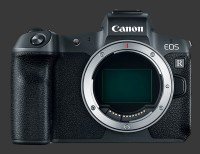
Canon EOS R and RP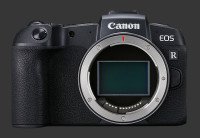
Canon EOS RP. While several of their controls are familiar to Canon DSLR users, the R5 interface is greatly improved and offers far more customization points which makes it operate like a completely different camera.
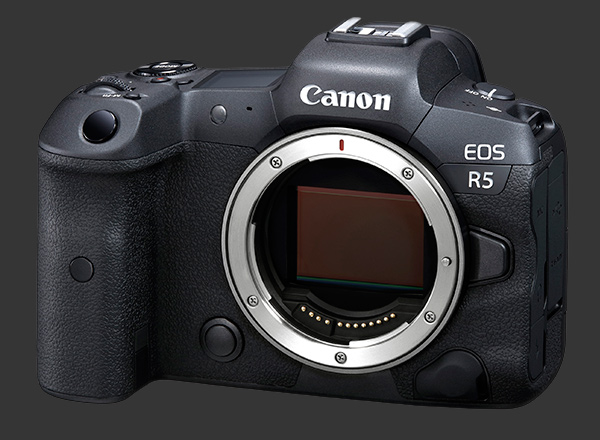


Canon EOS R5 Design
The R5 looks like a cross between the R and 5D Mark IV. Its mirrorless design - hand-grip excluded - allows the main body to be slimmer than a DSLR but a deep grip makes it thicker than the Canon EOS 5D Mark IV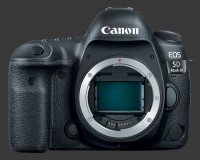
Canon EOS 5D Mark IV which improves purchase and houses a large battery. The hand-grip is tall and thick with an indentation for support. The camera feels very secure to hold and quite solid with the exception of the rotating LCD hinge while being 20% lighter than the 5D Mark IV. The body is rounded with gentler curves.
Holding the Canon R5 is comfortable with plenty of buttons and dials within easy reach. This camera body has a typical weight for a Full-Frame Mirrorless and feels dense. Most Canon RF lenses are designed for optical performance and they add a lot of weight, making the RF-system one of the heaviest. The most notable change from the original EOS R is that the viewfinder was lowered to reduce the camera height, even while keeping the same EVF size and magnification.

Ergonomics
A huge number of controls are scattered around the right top and back of the camera, while the front has a few points-of-interest. The deep grip has a rubberized coating to prevent slipping. The only infrared receptor on the camera is placed at the center of the grip to operate the camera remotely from in-front rather than behind. A standard two-stage shutter-release with moderate travel and a soft halfway point is angled near the top of the hand-grip. Its softness reduces camera shake while make it possible to accidentally release when one is holding focus while waiting for a precise moment.
A large button on the side of the RF-mount serves to release the lens. At the lower corner there is a rubber flap to cover a proprietary Canon connector. On the opposite side of the mount, a customizable button activates DOF-Preview by default. It can be switched between an impressive 36 functions: DOF-Preview, Metering & AF Start (Same as the Shutter-Release), AF Stop, AE Lock & AF Stop, AF Selection, Focus-Point Centering, Switch AF Point, Direct AF Selection, AF Drive, Eye-Detection AF, Touch AF, Eye-Detect Selection, Focus Peaking, Focus Guide Toggle, AE-L, Hold AE-L, AE-L/AF-L, EC, ISO, Flash Function, FE-L, Movie Record, Dial Settings, LCD Backlight, LCD Info, Mode, Auto Parameter in Flexible Exposure Mode, Auto Reset All in Flexible Exposure Mode, Quick Menu, Electronic Zoom, Playback Magnify, Custom Memory, Menu, Image Quality. RAW/JPEG Toggle, RAW/JPEG Switch, Cropped Aspect-Ratio, Drive Mode, Auto Lighting Optimizer, Picture Style, Touch Shutter, Protect, Rating, Folder Select, Folder Create, Maximize Display Brightness, Display Off, EVF/LCD Switch, ECO Mode or WiFi & Bluetooth.

The top plate of the Canon R5 is really packed. Recessed eyelets for the included neck-strap are positioned symmetrically which keeps them from digging into the hand of the photographer. On the left shoulder of the camera, there is a simple rotating powers-switch and a small speaker. Then there is the EVF housing with a standard Hot-Shoe. To its right, a square monochrome trans-reflective display with 128x128 resolution shows information about the camera. When the camera is off yet with a battery inside, it display the Exposure-Mode.
With the camera turned on, the status display can switch between two modes by quickly pressing a small flat button next to it. One mode shows the Exposure Mode, all exposure parameters plus battery-life. The other, displays Autofocus, Drive Mode, White-Balance, Metering Mode, Picture Style, Card Selection, Video Exposure Mode, Video Resolution and Frame-Rate. A long press of the same button reverses the display so that it shows black on white for a few seconds.
Exposure-Mode is set by tapping the circular mode button and then rotating any of the three control-dials. This cycles over all possible Exposure Modes for either stills or video. A button on the back of the camera toggles between the two. There are 10 modes to choose from on the Canon EOS R5:
- Auto: A fully automatic mode featuring Scene Recognition.
- All 4 standard PASM modes: Program with Shift, Aperture-Priority, Shutter-Priority and Manual.
- BULB: A separate mode for manual or timed Bulb exposures. The Shutter-Release must be held down during the entire exposure for Manual Bulb which is unfortunate. Luckily a Bulb Timer can be set for up to 100 hours minus one second. It is surprisingly inefficient to set though. One must enter the Camera menu, cycle to Page 6, select Bulb Timer, set it to Enable, then press Info to bring up the time display and then change one unit at a time by selecting it and rotating a control-dial! Given the camera has triple control-dials and only two are used in Bulb mode, one for the aperture and the other for ISO, it is strange that the third dial cannot be used to change the exposure duration.
- A new Flexible-Priority mode where the front control-dials changes a parameter while the top one selects the parameter. After a parameter is changed, pressing Delete reverts it to Auto. This is a quick and innovative way to control any parameter without switching Exposure Mode.
- Three Custom modes which can be set to any other mode, along with other settings.
All these modes except for Flexible-Priority and BULB are available for video recording. A Record button near the corner of the status display starts and stops video capture by default. When the camera is set to any stills Exposure Mode, the Record button arbitrarily films using the Custom 3 mode. Of course since, it is impossible to preview the video recording area without activating a Video Exposure Mode, it is better to reassign the button to a useful photography feature. There are 35 to choose from, the same as for the DOF-Preview button listed above, minus the first two, plus Video Record.
A small button, almost flush with the camera surface, locks some controls on the camera. A Setup menu item offers 6 lockable items: All three control-dials, the 8-way joystick, the touchscreen and the lens control-ring. Pressing the Lock button prevents the selected controls from changing anything. If only the rear control-dial had stiffer detents, there would be little reason to have this. It does serve as a way to toggle touchscreen functionality without entering the menu system.
Two control-dials are located on top of the Canon R5. They are oddly customizable: The front control-dial can be configured only for Manual Exposure Mode while the rear can be customized for all modes to control any exposure-parameters plus 6 other functions! Although limited in choice, this camera can be incredibly efficient by simply configuring the front dial to control aperture and the rear dial to change ISO sensitivity. This leaves the third control-dial, located on the back of this mirrorless, to set Shutter-Speed in Manual mode and Exposure-Compensation otherwise. In unprecedented flexibility for Canon, the R5 allows users to reverse the rotation of control-dials and the lens control-ring.

The back side of the Canon R5 is even more densely packed than the top plate. A sliver of body on the right side is rubberized to provide purchase over the camera with a small protrusion to avoid the thumb slipping off. Several buttons are within easy reach of the thumb, yet many are not distinguishable by feel which makes for a steep learning curve.
At the top left, there is a Rate and a Menu button. The former sets the image rating in Playback mode and records a voice memo during Instant Review. The latter simply enters and exits the menu system. This forces the camera body to be held by two hands but this can be changed by assigning a different button to access the menu system. An issue prevents this from working fully since navigating sub-menus requires the actual Menu button rather than the reconfigured one.
Skipping over the viewfinder for a moment, one finds an 8-way joystick to control focus selection. It moves a point or area quickly anywhere in the frame. The joystick is also clickable which resets focus to the center. Immediately to its right, the AF-On button can be set to any of the same 36 functions as DOF Preview. It is convenient to set this button to Exposure-Compensation to avoid straining to reach the lower control-dial which is also prone to accidental rotation but can be locked.
Further right, a pair of buttons will be familiar to Canon users but mysterious to everyone else. The asterisk stands for AE-L. Normally these is a sticky control, and it works this way by default on the R5, but it can be converted to a more friendly AE-L Hold button or any of the same 36 functions as AF-On. The button right next to it changes Focus Selection Modes. There are two ways to configure it, one using the main control-dial, the other by pressing the M-Fn button together. It is much easier to use the control-dial, which is not the default, so use Page 4 of the Autofocus menu to change that by selecting AF method selection control.

Heading down from the 8-way joystick there is a cluster of three buttons which are easy to confuse due to their identical size and shape. The top is Magnify. In Capture mode, it cycles over normal viewing, 6X and 15X Electronic Magnification. This MF-Assist mode enlarges the selected focus area to ensure critical focus. In Playback mode, it operates differently which is a little frustrating. Instead of cycling, it toggles a mode where the the top-rear control-dial controls magnification.
Right below the Magnify button, there is an Info button of unparalleled flexibility. This button cycles over five display modes for Capture. Users are able to customize what three of the 5 modes show. Options include a 2-axis Digital-Level and an accurate Live-Histogram showing Luminance or RGB distribution. It cycles over up to a whopping 11 display modes for Playback! The histogram shown in 10 of these modes is customizable too.
The Quick Menu (Q) button is a Canon classic. It brings up an iconic menu showing 11 features. The lower-rear control-dials selects the feature to change, while either top control-dial changes its value. This is a great away to access functions that are not mapped directly to a button without entering the menu system.
Another Canon classic is the vertical control-dial found on the back of their advanced DSLRs which makes it appearance on the R5. On a DSLR, this is the second control-dial but it now becomes the third since there are already two on the top-plate. This one is less comfortable to reach since it requires shifting the grip down. It also has softer detents then the other two which makes it prone to accidental changes. For this reason, most Canon DSLRs have lock button specifically for that dial. With the EOS R5 though, the lock button on the top-plate is customizable to include other dials. By default, this dial sets Exposure-Compensation but one can map EC to a different dial or lens control-ring combined with a button-press.
Two buttons are found below the lower-back control-dial: Playback and Delete. Their operation is just as expected. Playback enters or exists Playback mode, although the Canon EOS R5 is Shooting-Priority, so a quick tap of the shutter exits Playback mode anyway. Delete prompts for deletion during Playback or Instant Review. When an image is saved in multiple formats, options to delete both or one file are available.

EVF & Displays
Canon included one of the best viewfinders on the market, a 0.5" EVF with an ultra-sharp 5.8 megapixels of resolution, large 0.76X magnification, 100% coverage and an essential Eye-Start Sensor. This display shows the most accurate Live-View of recent times that previews exposure, white-balance and colors in all exposure modes. Motion is very fluid with virtually no lag thanks to its 120 FPS refresh rate. An optional Live-Histogram can be super-imposed and is more accurate than most.
The LCD on the back of the R5 is very sharp too with 2.1 megapixels of resolution. This large 3.2" panel lacks an anti-reflective coating which gives it poor visibility in bright light which is definitely odd for such a high-end offering. The other issue with the screen is that it is mounted on a rotating hinge. While this has the advantage of being able to make it front-facing, it is awkward and unwieldy for every thing else. When framing at low or high angles, the screen protrudes and does not stay completely level. This makes it especially difficult to adjust framing precisely as the axis of the rotation of the camera is different from the screen.
This display optionally acts as a touchscreen. Luckily, this can be disabled entirely or locked by the Lock button to avoid accidental changes. Although, it gives familiarity to smartphone users, there is really no need for a touchscreen on a professional camera, particularly when it offers so many customizable physical controls.
Ports & Doors
On the right side of the camera, there are three rubber flaps that reveal no less than five ports. One flap covers two 3.5mm stereo mini-jacks for recording or playing back audio externally. Another hides the Sync-Port used for legacy studio lighting. This has been widely replaced via wireless triggers but it there just in case. The final flag covers a USB-C port and Micro HDMI connector supporting up to 4K output.
The left side of the camera has a sturdy plastic door that covers dual memory-card slots. The rear slot takes CF Express cards which have the same form-factor as XQD but the Canon EOS R5 only supports CF Express there. These memory-cards reach ultra-fast transfer speeds upwards of 1 GB/s by using a PCI-E bus. 8K and high-speed 4K video can only be recorded to that slot. There is a second memory-card slots that accepts SDXC memory-cards which are much cheaper and widely available. Although this allows photographers to use their existing cards, managing two types of cards of different maximum speeds is not worth it. In Backup mode, maximum speed and buffer-depth becomes limited by the slowest card.

Beneath the camera, a sturdy plastic door covers the battery-compartment. There is a port inside the compartment to connect a battery-grip. The door is sufficiently far from the tripod mount that changing batteries is possible without unmounting the camera from a tripod. The mount itself is a standard metal thread inline with the optical center of the camera which is ideal for panoramic photography.
The most problematic issue with any Interchangeable Lens Digital Camera is sensor-dust. Unlike with a film camera where a new negative slides behind the shutter for every photo, a digital camera leaves the sensor in-place. Any dust that lands on the sensor is likely to stay there due to static caused by current required to power the sensor itself. Modern digital cameras usually offer a sensor-cleaning function that vibrates the sensor to shake-off dust. The R5 support this too. While, better than nothing, these systems have a very low success-rate. Canon cleverly keeps the shutter of the R5 closed when the camera is powered off by default. Although not a dust-proof seal, this greatly reduces the risk of sensor dust. Canon should be applauded for coming up with such a simple way of improving the situation. One hopes it is possible to implement this on all digital cameras via a updated firmware.

Overall Usability
There is no doubt that the Canon EOS R5 is the most efficient Canon camera ever made. Its triple control-dials instantly place it ahead and their high-level of customization makes it possible to fine-tune the experience. While holding the camera at eye-level, both top control-dials the 8-way joystick and 10 buttons are all reachable without shifting grip! This is truly exceptional, although the three buttons right below the thumb have identical feel which makes them error-prone.
This camera has such a huge feature-set that, even with so many physical controls, many remain accessible only through the menu system. It has a nice visual design and easy navigation but several features are oddly separated and intuitive to access: While AEB steps are controlled by the an option on Page 2of the Camera menu, the number of frames taken is selected on Page 1of the Customization menu. With a control-dial to spare, this could have easily been configured for the same screen. Bulb Timer and Interval Timer details are similarly difficult to reach. Focus Bracketing requires a different sequence of buttons which is confusing. Another strange on is Image Quality that can select RAW and an image format but that second format is decided by the HDR PQ option on the next page! All this can probably be fixed via firmware update, if enough photographers request it.
Canon users will be at an advantage when learning to use the EOS R5 but the camera is fairly easy to use. It is comfortable and highly customizable to optimize its use for different needs. The new Flexible-Priority mode is a clever way to essentially access all Exposure Modes, other than BULB, without using the Mode button.
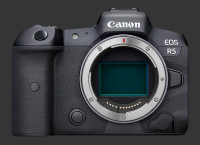 |
Please Support Neocamera
All information on Neocamera is provided free of charge yet running this website is a huge endeavor. Purchases made via affiliate links found throughout the site help keep it running and up-to-date. There is no additional cost to you, so please consider buying via these links to our affilates:
If you found any information on this site valuable and did not purchase via our affiliate links, please considering donating via PayPal:
Any amount will be greatly appreaciated. Thank you for your support!
Canon R5 Highlights

Sensor-Size: 36 x 24mm

Actual size when viewed at 100 DPI
| 45 Megapixels Mirrorless | ISO 50-102400 |
| Canon RF Mount 1X FLM | Shutter 1/8000-30s |
| 5-Axis Built-in Stabilization, 8-Stop Improvement | Full manual controls, including Manual Focus |
| 0.50" Built-in EVF 5.8 Megapixels (0.76X) | Custom white-balance with 2 axis fine-tuning |
| Automatic Eye-Start sensor | Spot-Metering |
| 2 Axis Digital Level | Hot-Shoe |
| Weatherproof | Stereo audio input |
| Built-in Dust Reduction | Lithium-Ion Battery |
| 20 FPS Drive, 170 Images | CF Express Type B, Secure Digital Extended Capacity |
| 8192x4320 @ 30 FPS Video Recording | |
| 3.2" LCD 2.1 Megapixels |
Updates
2025.01.18

Fujifilm GFX 2025 Lens Roundup
Lens Review roundup of Fujifilm GFX Medium-Format lenses. Quality, performance and handling of the GF20-35mm F/4R WR, GF30mm F/3.5 Tilt-Shift and the GF55mm F/1.7.
2024.11.18

Best 2024 Photography Gifts for Every Budget
Great gifts for photographers and photo enthusiasts selected for every budget among the best products of 2024.
2024.08.07

Eye Protection Tips for Professional Photographers
The four main considerations for professional photographers regarding eyewear.
2024.07.14

Fujifilm X100VI Review
Flagship fixed-lens compact digital camera with a 40 MP sensor and Image-Stabilization, a first for the series. Retro design featuring dual control-dials, plus direct ISO, Shutter-Speed and EC dials. Its hybrid viewfinder can switch between EVF and OVF mode.
2024.05.09

Fujifilm GFX100 II Review
Flagship 102 Megapixels Medium-Format Mirrorless Digital Camera with 8-Stop 5-Axis IBIS, 8 FPS Drive, 8K Video and 400 MP Super-Resolution capture in a weatherproof and freezeproof body with dual control-dials and dual memory-card slots.
2024.04.03

Fujifilm X-T5 Review
Newest Fujifilm flagship boasting a 40 MP APS-C sensor, 5-axis IBIS with 7-stop efficiency, 15 FPS continuous drive, 6.2K Video capture, dual control-dials and dual SDXC UHS-II slots in a sturdy weatherproof and freezeproof body.
2023.11.20

Best Digital Cameras of 2023
Find out which are the Best Digital Cameras of 2023. All the new Mirrorless Digital Cameras from entry-level to high-end professional.
2023.07.10

Fujifilm X-H2 Review
40 Megapixels APS-C Hybrid Mirrorless Digital Camera with 7-stop IBIS. Fastest shutter ever and 8K video capture. Large builtin EVF with 0.8X magnification and 5.8 MP, plus an Eye-Start Sensor. Packed with features and large number of controls in a weatherproof and freezeproof body.
2023.05.07

Sony FE 20-70mm F/4G Review
Review of the unique Sony FE 20-70mm F/4G lens. The optical zoom of this lens spans ultra-wide-angle and medium focal-length coverage, making it one of the most versatile Full-Frame lenses on the market.
2023.01.15

Huion Inspiroy Dial 2 Review
Review of the Huion Inspiroy Dial 2 tablet, a medium sized drawing surface with dual dials and customizable buttons. Connects via USB-C or Bluetooth 5.0 with Windows, Linux and Android support.
2022.12.08

How to Pack for a Photo Trip
Find out how to pack for a travel photography trip, carry your gear safely while meeting airline regulations.
2022.11.13

Best Digital Cameras of 2022
The best digital cameras of 2022. A short list of the most outstanding models in their respective categories. Choose one for yourself or as a gift.












